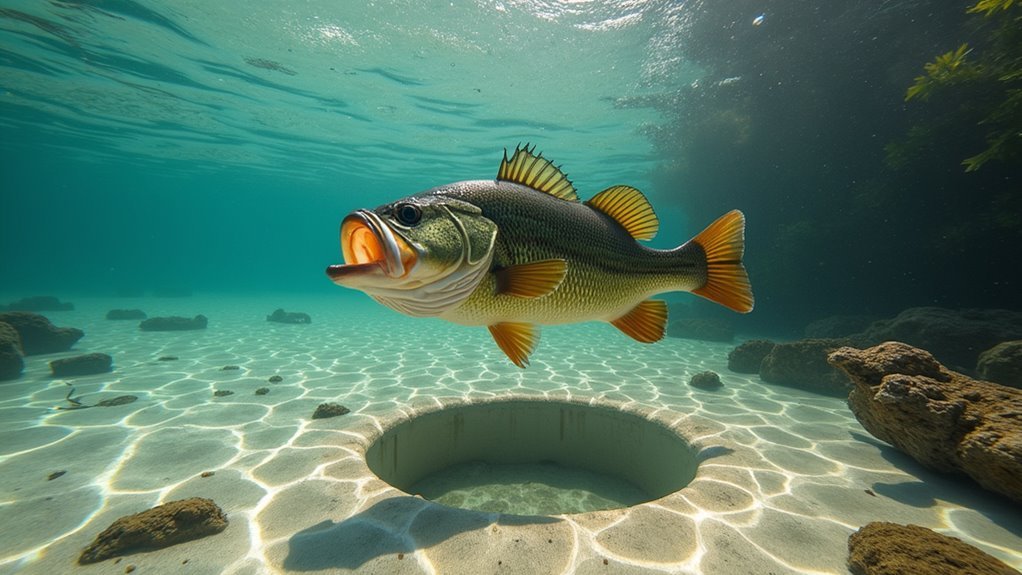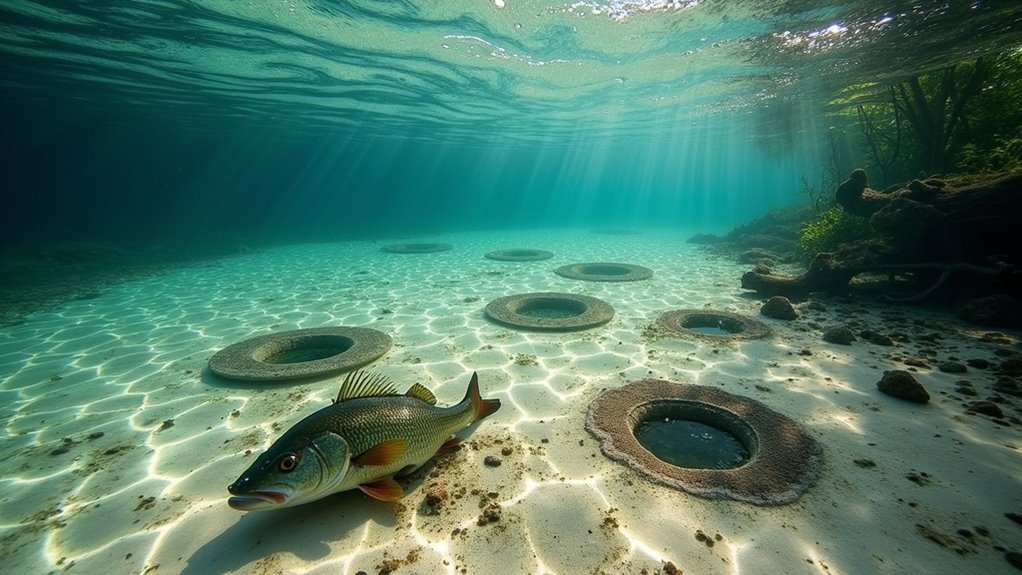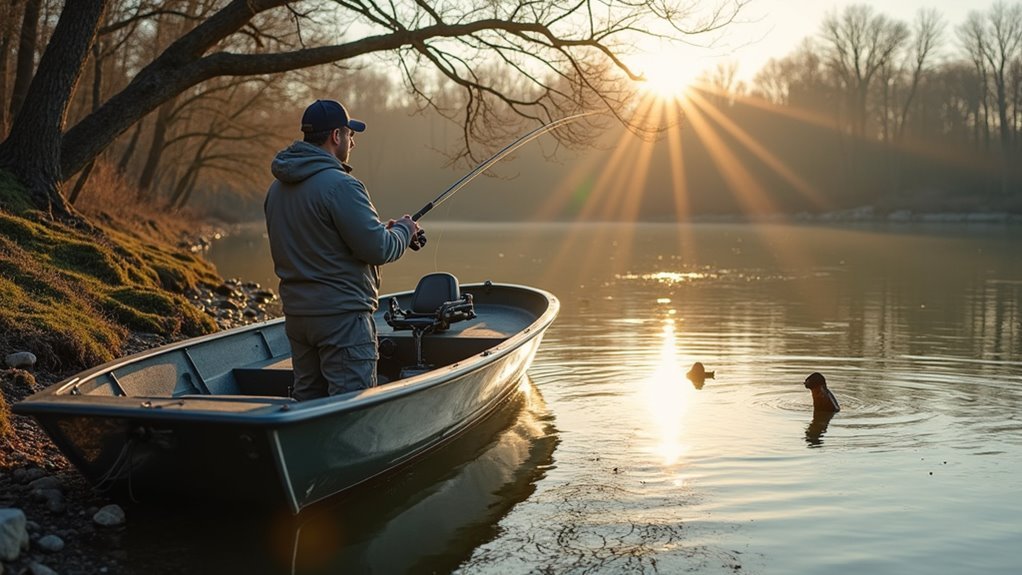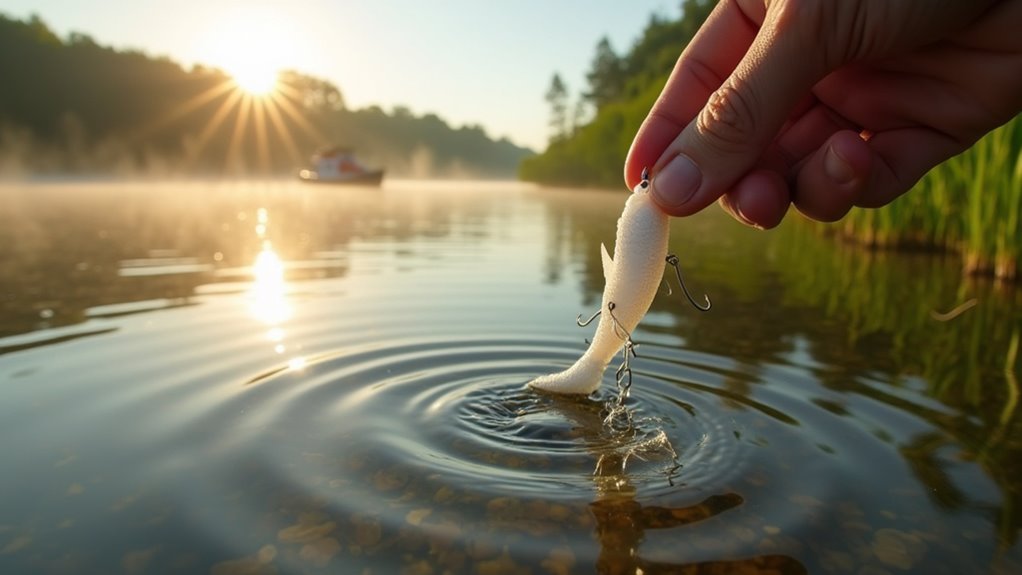Bass spawning season hits when water temperatures climb above 60°F, typically February in southern states and May-June in the Great Lakes. We’ll find bass moving to shallow waters with hard bottoms—sand, gravel, or clay—at 1-4 feet deep. Males build and guard nests while females lay eggs. During this three-week window, sight fishing with soft plastic lizards or weightless Senkos works wonders. Stick around to discover the regional secrets that’ll fill your livewell.
Understanding Bass Spawning Cycle And Timing

While most anglers impatiently wait for warmer weather to hit the water, understanding the bass spawning cycle can give you a real edge during this critical time.
We’ve found that spawning occurs nationwide at different times—Southern states like Texas might see action as early as February, while up in the Great Lakes, bass won’t spawn until May or June.
The magic happens when water temperatures climb above 60°F. That’s when bass move from deep winter hideouts to shallow waters to build their nests. The males get protective, the females lay eggs, and for about three weeks, it’s a fishing opportunity you don’t want to miss.
Identifying Prime Spawning Locations And Water Conditions

Now that we recognize when bass spawn, let’s talk about where they’re setting up shop. Bass prefer shallow waters with hard bottoms—sand, gravel, or clay—where they can build their nests. Look for these spots in 1-4 feet of water near protective cover like fallen trees, docks, or vegetation.
Water temperature is vital—they want steady temps above 60°F. I once found a goldmine of spawning beds in a protected cove where the morning sun had warmed the water perfectly. The clearer the water, the deeper they’ll typically nest. Remember, they love areas that offer protection from wind and predators.
Pre-Spawn Fishing Strategies That Deliver Results

Three key strategies dominate successful pre-spawn fishing when bass are actively feeding before their reproductive ritual begins. First, target shift areas where bass move from winter depths toward spawning flats—points and channel edges are gold. Second, match your retrieval speed to water temperature—slower in cooler water, faster as it warms. Third, use reaction baits like lipless crankbaits and spinnerbaits when bass are aggressive.
We’ve found that bright-colored lures work wonders during cloudy days. Last spring, my buddy Mike and I hammered largemouth on chartreuse spinnerbaits along a warming creek channel—they couldn’t resist!
Effective Lures And Techniques During Active Spawning

Once bass settle into their spawning beds, your lure selection must change dramatically to entice these protective parents. We’ve found that sight fishing becomes essential during this phase. Look for those circular depressions in shallow water and approach quietly.
Spawning bass demand stealth and precision—spot those shallow beds and adapt your approach for protective fish.
- Soft plastic lizards or salamanders that mimic nest predators trigger defensive strikes
- Weightless wacky-rigged Senkos with a slow fall that hovers in the strike zone
- White tube jigs that resemble small baitfish threatening the nest
- Finesse jigs with minimal movement that can be placed directly on beds
- Small, translucent dropshot baits for exceptionally clear water conditions
Post-Spawn Fishing Adjustments For Continued Success

After the spawning frenzy subsides, many anglers mistakenly think the prime bass fishing season has ended – but we’ve learned that’s far from true!
Post-spawn bass typically move to deeper waters as they recover. We’ve had great success targeting areas near drop-offs where bass rest after the energy-draining spawn. Try fishing earlier in the morning or later in the evening when temperatures are cooler.
Switch to deeper-running crankbaits and jigs that mimic crawfish – this has saved many of our fishing trips in June. Remember to slow your retrieve, as post-spawn bass often aren’t as aggressive. Patience pays off!
Regional Differences In Bass Spawning Behavior
While bass spawning follows the same biological imperatives across North America, the timing and behavior vary dramatically from region to region. We’ve seen firsthand how bass in Florida might be on beds in February, while our northern friends are still ice fishing! These regional differences impact everything from lure selection to fishing strategies.
- Southern states (Texas, Florida) see spawning as early as February
- Mid-Atlantic regions typically experience spawning in April
- Great Lakes bass often wait until late May or early June
- Western reservoirs vary widely based on elevation and water temps
- Coastal regions face tidal influences that create unique spawning patterns
Frequently Asked Questions
Is Catch-And-Release Ethical During Spawning Season?
We believe catch-and-release can be ethical during spawning if we’re careful. We should minimize stress on fish, use proper handling techniques, and return them quickly to protect breeding populations.
How Does Bass Spawning Affect Other Fish Species?
During bass spawning, we’ve seen up to 40% reduced feeding in other fish species. Bass defend territories aggressively, pushing out competing fish and potentially disrupting their feeding and reproductive patterns too.
Can Bass Spawn Multiple Times in One Season?
No, bass can’t spawn multiple times in one season. They only reproduce once annually during spring when water temperatures reach above 60°F. We’ll catch them more easily during this period.
Does Moon Phase Impact Bass Spawning Activity?
Like clockwork in the cosmos, we’ve found moon phases do influence bass spawning. They’re particularly active during full and new moons when gravitational pull affects water temperature and light conditions they need for reproduction.
Are Bass More Susceptible to Diseases During Spawning?
We’ve found that bass are indeed more vulnerable to diseases during spawning, as the stress of reproduction weakens their immune systems while they’re concentrated in shallow waters with increased contact.
Conclusion
We’ve covered everything from water temperature monitoring to regional timing differences in this guide. Remember, success during spawning season means adapting your approach as bass move through their reproductive cycle. Did you know that male bass guard their nests for up to two weeks after hatching? That’s dedication! By understanding these patterns and applying the right techniques at each stage, we’ve turned what could be frustrating weeks into our most productive fishing opportunities. Tight lines!